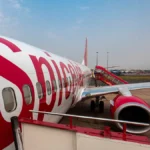Airline adds five aircraft this month; targets doubling capacity and tripling ASK by end-2025
Gurugram, October 28, 2025:

Low-cost carrier SpiceJet has further expanded its operational fleet with the induction of another Boeing 737 aircraft and the reintroduction of a 737 MAX into active service. With these additions, a total of five aircraft have joined the airline’s fleet in October, signaling the company’s most aggressive expansion phase in recent years.
The move comes as SpiceJet gears up for the winter travel season, traditionally a high-demand period driven by holidays and festive travel. The airline said the expansion aligns with its strategy to strengthen connectivity, increase capacity, and enhance route flexibility across domestic and regional markets.
Both aircraft have now commenced commercial operations. Earlier this month, the airline inducted two Boeing 737s and one wide-body Airbus A340, as part of its plan to add 20 aircraft between October and November 2025.
Focused on Meeting Soaring Passenger Demand
SpiceJet’s Chief Business Officer Debojo Maharshi said the additions underscore the airline’s focus on scaling up operations during one of the busiest periods for Indian aviation.
“Our latest inductions and the return of another 737 MAX to active service mark another strong step in SpiceJet’s growth story,” Maharshi said. “This is one of our largest-ever expansion phases, driven by a clear focus on meeting the surge in travel demand and offering our passengers more destinations, enhanced connectivity, and greater convenience.”
The airline aims to more than double its capacity and triple its Available Seat Kilometres (ASKM) by December 2025, marking a major milestone in its turnaround and growth strategy. ASK is a key industry metric that measures the airline’s total passenger carrying capacity across its network.
Strategic Timing and Market Implications
The expansion comes amid improving domestic air traffic trends and declining aviation turbine fuel (ATF) prices, which have provided a favorable environment for capacity growth. India’s air passenger market has seen double-digit growth through 2025, driven by rising disposable incomes and a surge in regional connectivity demand.
Analysts note that SpiceJet’s latest fleet additions are crucial to regaining market share lost during previous years when operational and financial challenges constrained its network.
“SpiceJet’s decision to induct additional aircraft ahead of the winter season is both strategic and necessary,” said an aviation sector analyst at ICRA. “It helps them capitalize on pent-up travel demand while strengthening their reliability and frequency in key routes.”
The airline’s renewed focus on operational efficiency, backed by IATA-IOSA certification, reflects its efforts to rebuild customer confidence after earlier disruptions in aircraft availability.
Fleet and Operational Overview
SpiceJet currently operates a diverse fleet of Boeing 737s, Q400 turboprops, and Airbus A340s, serving major metros as well as regional destinations under India’s UDAN (Ude Desh ka Aam Nagrik) connectivity scheme. The majority of its aircraft now feature SpiceMax — India’s most spacious economy-class seating configuration.
Industry watchers see the return of 737 MAX aircraft as significant, as it allows the airline to operate more fuel-efficient flights with extended range and reduced operating costs. The model’s reintroduction had been delayed globally following regulatory reviews, and its return signals renewed fleet stability for the carrier.
The airline’s medium-term plan focuses on network expansion, cost optimization, and high-yield route penetration. With the winter schedule expected to drive occupancy rates beyond 85%, the timing of these inductions could improve revenue per available seat kilometre (RASK).
Looking Ahead
By December 2025, SpiceJet’s expanded fleet is projected to more than double its total operational capacity, enabling the airline to serve new domestic and international routes. The company is also in discussions with lessors for additional aircraft to sustain momentum into the 2026 summer schedule.
For passengers, the expansion translates into more flight options, improved connectivity, and competitive fares, while for the airline, it represents a crucial step in restoring profitability and reasserting its position as one of India’s leading low-cost carriers.
